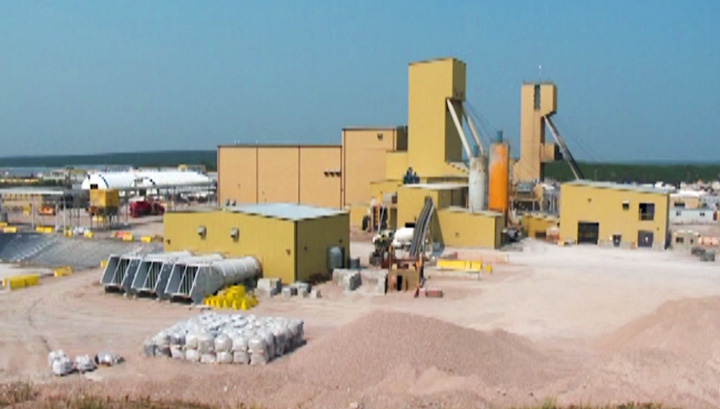With a pair of oversized scissors and a stretch of silver ribbon, Cameco chief executive Tim Gitzel and the company’s partners on Wednesday officially completed a 34-year quest to open the Cigar Lake uranium mine. Since its discovery in 1981 the project has lain idle as uranium markets languished, suffered catastrophic floods in 2006 and 2008 after construction began, and saw costs explode from an originally estimated $450 million to $2.6 billion as the company tried to open the complicated and challenging mine.

“We didn’t know what we were dealing with when we started this mine,” said Gitzel at the opening.
“But today here we are, the mine’s producing, the mine’s been producing, the team’s in place, all the partners are here to celebrate, so really it’s a great day.”
The mine and the McClean Lake processing mill finally started production last year, but the official launch was held off until Wednesday – in part because of wildfires that delayed the original ceremony scheduled for July.
The mine, which Cameco operates and half-owns, is expected to run for at least 15 years. The mine currently employs more than 600 people, with more than half from northern Saskatchewan.
READ MORE: Cameco stops some work at Cigar Lake uranium mine in Saskatchewan
A senior executive of France’s Areva, which owns 37.1 per cent of the mine and 70 per cent of the mill, said the safe startup and continued production from the operation were cause for celebration.
The uranium deposit sits in difficult ground almost half a kilometre underground, which has made the project a challenge from the start, said Gitzel.
“This is very tricky, delicate, complex geology here that we’re working in,” said Gitzel.
“We’ve really had to adapt and be innovative, invented a lot of new techniques that we’re employing to run this mine now.”
Because the uranium mine sits in unstable, water-logged sandstone, Cameco (TSX:CCO) has resorted to freezing the thousands of tonnes of uranium-rich rock through a vast network of pipes filled with brine solution chilled to minus-30 degrees.
Cameco has also developed and customized machines that shoot water at supersonic speeds to cut away the rock. Chunks of rock and water are then piped to tanks – where the water is recycled back into the system and the rock is crushed into a sand that’s then piped to the surface and trucked to the McClean Lake mill.
But the company has continued to push through the challenges because the mine has such high concentrations of uranium, more than 100 times higher grades than the world average.
READ MORE: Cameco’s Cigar Lake plant in Saskatchewan finally producing ore
“We always knew this was a special mine, very very high grade, a large deposit, yes difficult geologic conditions, but I don’t think there was any doubt that we would someday bring it into production,” said Gitzel.
Bill Boyd, Saskatchewan’s minister for energy and mines, was on-site for the ribbon cutting and lauded the benefits of the project.
“Today’s a very important day for the companies, a very important day for employment in Saskatchewan, investment in Saskatchewan, and clearly it’s a huge benefit to all of the province of Saskatchewan.”
Construction began in 2005, but it was delayed for years because of the floods. More delays came in 2013 when key holding tanks were found to be leaking water and required new steel liners, and then in 2014 the company again had to halt operations as it found the ground wasn’t freezing fast enough.
Production did get going last year, and the company declared commercial production earlier this year.

Comments